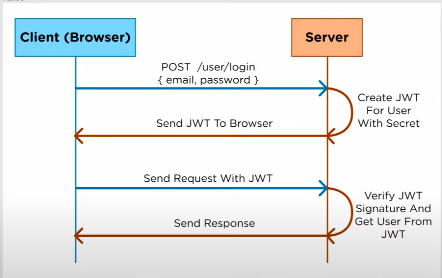JSON Web Tokens (JWT)
Authentication vs Authorization:
Authentication:
- The process of verifying a user’s identification through the acquisition of credentials and using those credentials to confirm the user’s identity. Typically done through gathering a username and password from a user and comparing them with stored credentials.
Authorization:
- The process of allowing authenticated users access to resources by determining whether they have system access permissions.
JWTs' provide a form of authorization. When a user logs into a website, the site will generate a JWT that contains information about the user. This info is then stored client side. Now, the client can send requests using this ADD CONTENT

JWT’s are composed of a header, payload, and signature. Each section is separated by a period. When encoded, have the following structure: xxxxx.yyyyy.zzzzz
All three sections are base64url strings.
Header
The header is typically comprised of the hash method used in the signature section of the JWT as well as the type of token (JWT).
Example: { "alg": "HS256", "typ": "JWT" }
Payload
The payload consists of claims AKA statements about an entity (typically, the user). These claims can come in 3 types:
- Registered Claims
Claims that are predefined by JWT and are recommended, but not required (typically to allow interpolation with third party applications). Some examples of these registered claims are...
- iss (issuer): Issuer of the JWT
- sub (subject): Subject of the JWT (the user)
- aud (audience): Recipient for which the JWT is intended
- exp (expiration time): Time after which the JWT expires
- nbf (not before time): Time before which the JWT must not be accepted for processing
- iat (issued at time): Time at which the JWT was issued; can be used to determine age of the JWT
-
jti (JWT ID): Unique identifier; can be used to prevent the JWT from being replayed (allows a token to be used only once)
-
Custom Claims:
Claims that are determined and designed by the developer sending the JWT, containing generic information like name and email.
-
Public Claims: Collision-resistant names defined universally and used for public consumption.
-
Private Claims: Claims that are known only to the producer and consumer of a JWT. Private claim names are not collision-resistant and should be used with clear understanding of this and care
Signature
To generate the JWT signature:
- base64encode your header
- base64encode your payload
- combine the two with a period between them
- hash them using a 256 bit secret
The Full JWT
The entire JWT will be the following:
{encoded header}.{encoded payload}.{signature}